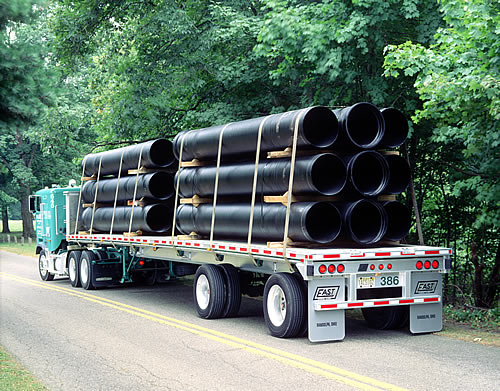Drivers can be killed, injured and otherwise discomforted by falling, shifting cargo, fork lift failures, crane failures, belts, straps, winches, stakes, dunnage, and other equipment which can fail or mishandled in some fashion or another while flatbed trailers are being loaded or unloaded.

Drivers need to be keenly aware of the safety policies of the company where they’re loading and unloading, as well as the company equipment and operators doing the job. Remember the word “Knowledge” –the more you know, the less chance you have of becoming a victim. The more the trucking company knows, and the more information they transfer to the driver, the less likely it will be the driver becomes injured or killed while the truck is being loaded or unload. As an example, the truck company and the driver need to know and understand the safety concerns a company has to comply with under the Washington DC Based: Occupational Safety & Health Administration (OSHA) Regulations.
For example:
Cranes and derricks. - 1926.550
1926.550(a)(9)
Accessible areas within the swing radius of the rear of the rotating superstructure of the crane, either permanently or temporarily mounted, shall be barricaded in such a manner as to prevent an employee from being struck or crushed by the crane.
Hoisting and rigging. - 1926.753
Working under loads.
1926.753(d)(1)
Routes for suspended loads shall be pre-planned to ensure that no employee is required to work directly below a suspended load except for:
1926.753(d)(1)(i)
Employees engaged in the initial connection of the steel; or
1926.753(d)(1)(ii)
Employees necessary for the hooking or unhooking of the load.
1926.753(d)(2)
When working under suspended loads, the following criteria shall be met:
1926.753(d)(2)(i)
Materials being hoisted shall be rigged to prevent unintentional displacement;
1926.753(d)(2)(ii)
Hooks with self-closing safety latches or their equivalent shall be used to prevent components from slipping out of the hook; and
1926.753(d)(2)(iii)
All loads shall be rigged by a qualified rigger
Knowledge and awareness is critical to safety. Take note of where OSHA says, “All loads shall be rigged by a qualified rigger.” Truck drivers always want to get the job done so they can get on the road and get paid. As a result, they are often inclined to help do the rigging. Very often this proximity to the not-yet-secured cargo can cause a driver to be injured. The driver’s best rule of safety is to stay out of the way. Don’t take a chance. Stay out of the reach of everything that can shift, roll, slide, and fall. Drivers are often killed or injured because they’re busy rolling up their straps, chains or cables while underneath the load they’ve just unstrapped. They fail to acknowledge cargo can shift and settle, and dunnage can break while driving down the road. When this happens, the load is not the same as when it was being strapped down. Equipment approaching such as forklifts, cranes, front-end loaders can all cause the ground to vibrate. Something can bump the trailer while the driver is putting the rolled up belts in the jockey box and fails to hear or feel the approach of equipment which could affect the load.
The latest thing which should be outlawed while the driver is securing or unsecuring his load are cell phones and other mobile devices. Concentration on doing the job at hand and self-safety should be much more important than a distraction which can take your attention off of doing the job, specifically analyzing where is the safest place to be. Personally, I’d rather be in the driver’s lounge. When it comes time to tie down I’d like to have equipment to hold the load in place, such as fork lifts, while I tie it down. If I’m going to use belly bands and strapping before the load is completed, I’d like to have it secured in such a way while I put the straps or belly bands in place.
As a driver, I recognize the fact that those who are loading or unloading are often in haste to get the job done. Therefore, be extremely careful for your own well-being. Stay well out of the way while the loading equipment is moving. And I mean, well out of the way. For instance, a 20 foot piece of pipe, picked up by a fork lift can slide off of the forks and wind up 10 or 15 feet behind the back of the trailer. You should have no intention of being that close, as a driver concerned with safety.
As far as chains, cables, or anything that can be under tension, you should be well out of the reach of any of these devices. That way if they break they can’t injure you. There are thousands of types of flatbed loads, and any number of securing or unsecuring problems. Therefore, a driver needs to read carefully the federal regulations. What exists in the Federal Motor Carrier Safety Regulations (FMCSRs) is in Section 393 titled “Parts and Accessories Necessary for Safe Operation”. Companies and drivers should review 393.100 titled “Which types of commercial motor vehicles are subject to the cargo securement standards of this subpart, and what general requirements apply” and note who is responsible for securing loads. In addition, there is nothing, in the FMCSRs regarding safety when unsecuring the load. But, there are certainly OSHA regulations regarding safety of which both the driver and truck company should be well aware. Truck companies should make sure drivers are well informed. Drivers should make it a priority to be well informed of the regulations.

